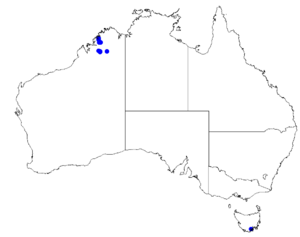Boronia pauciflora facts for kids
Quick facts for kids Boronia pauciflora |
|
|---|---|
| Conservation status | |
| Scientific classification | |
 |
|
| Occurrence data from Australasian Virtual Herbarium |
The Boronia pauciflora is a special plant found only in the Kimberley area of Western Australia. It belongs to the citrus family, called Rutaceae. This plant is a shrub that stands upright. It usually has simple leaves and pretty white or pink flowers with four petals.
What it Looks Like
Boronia pauciflora is a shrub with many branches. It can grow up to about 60 cm (20 in) tall. When it's young, it might be a bit hairy. Its branches are almost square-shaped. The leaves grow in pairs, one across from the other.
Older leaves are simple, meaning they are just one blade. They have a small stalk called a petiole, about 0.5–7 mm (0.02–0.3 in) long. Younger leaves are different; they have three leaflets and no stalk. The main part of the older leaves and the end leaflet of younger leaves are shaped like an oval or a spear. They are about 12–80 mm (0.5–3 in) long and 2–12 mm (0.08–0.5 in) wide. The side leaflets are similar but shorter.
The flowers are white to pink. They are shaped like an egg or a triangle. Usually, you'll find them growing alone, but sometimes in groups of up to three. They grow where the leaf meets the stem, on a small stalk about 4–23 mm (0.2–0.9 in) long. The four sepals (leaf-like parts under the petals) are egg-shaped or triangular. They are about 2.5–4.5 mm (0.1–0.2 in) long. These sepals almost double in size as the fruit grows. The petals are about the same size as the sepals and don't get much bigger. This plant flowers from May to July.
Its Name and History
The plant Boronia pauciflora was first officially described in 1918. A person named William Vincent Fitzgerald found a sample of it near Mount Broome in the King Leopold Ranges (now called Wunaamin Miliwundi Ranges). He wrote about it in a scientific paper.
The second part of its name, pauciflora, comes from Latin words. Paucus means "few" or "little", and -florus means "flowered". So, its name basically means "few-flowered boronia".
Where it Lives
This type of boronia plant grows in rocky areas. You can find it near the Prince Regent River, the Edkins Range, and the King Leopold Ranges. All these places are in the Kimberley region of Western Australia.
Looking After It
The Government of Western Australia's Department of Parks and Wildlife has given Boronia pauciflora a special status. It's called "Priority Three". This means that not a lot is known about this plant, and it's only found in a few spots. However, it's not currently in immediate danger of disappearing.


